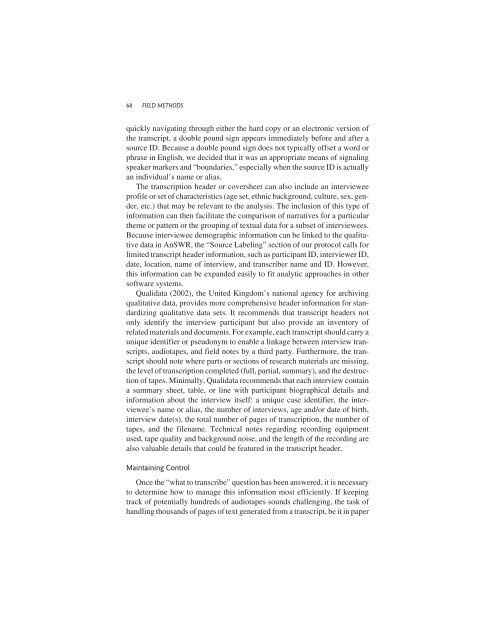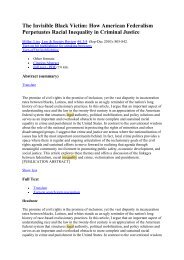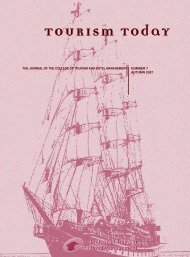Beyond the Qualitative Interview: Data Preparation and ... - E-Journal
Beyond the Qualitative Interview: Data Preparation and ... - E-Journal
Beyond the Qualitative Interview: Data Preparation and ... - E-Journal
You also want an ePaper? Increase the reach of your titles
YUMPU automatically turns print PDFs into web optimized ePapers that Google loves.
68 FIELD METHODS<br />
quickly navigating through ei<strong>the</strong>r <strong>the</strong> hard copy or an electronic version of<br />
<strong>the</strong> transcript, a double pound sign appears immediately before <strong>and</strong> after a<br />
source ID. Because a double pound sign does not typically offset a word or<br />
phrase in English, we decided that it was an appropriate means of signaling<br />
speaker markers <strong>and</strong> “boundaries,” especially when <strong>the</strong> source ID is actually<br />
an individual’s name or alias.<br />
The transcription header or coversheet can also include an interviewee<br />
profile or set of characteristics (age set, ethnic background, culture, sex, gender,<br />
etc.) that may be relevant to <strong>the</strong> analysis. The inclusion of this type of<br />
information can <strong>the</strong>n facilitate <strong>the</strong> comparison of narratives for a particular<br />
<strong>the</strong>me or pattern or <strong>the</strong> grouping of textual data for a subset of interviewees.<br />
Because interviewee demographic information can be linked to <strong>the</strong> qualitative<br />
data in AnSWR, <strong>the</strong> “Source Labeling” section of our protocol calls for<br />
limited transcript header information, such as participant ID, interviewer ID,<br />
date, location, name of interview, <strong>and</strong> transcriber name <strong>and</strong> ID. However,<br />
this information can be exp<strong>and</strong>ed easily to fit analytic approaches in o<strong>the</strong>r<br />
software systems.<br />
Qualidata (2002), <strong>the</strong> United Kingdom’s national agency for archiving<br />
qualitative data, provides more comprehensive header information for st<strong>and</strong>ardizing<br />
qualitative data sets. It recommends that transcript headers not<br />
only identify <strong>the</strong> interview participant but also provide an inventory of<br />
related materials <strong>and</strong> documents. For example, each transcript should carry a<br />
unique identifier or pseudonym to enable a linkage between interview transcripts,<br />
audiotapes, <strong>and</strong> field notes by a third party. Fur<strong>the</strong>rmore, <strong>the</strong> transcript<br />
should note where parts or sections of research materials are missing,<br />
<strong>the</strong> level of transcription completed (full, partial, summary), <strong>and</strong> <strong>the</strong> destruction<br />
of tapes. Minimally, Qualidata recommends that each interview contain<br />
a summary sheet, table, or line with participant biographical details <strong>and</strong><br />
information about <strong>the</strong> interview itself: a unique case identifier, <strong>the</strong> interviewee’s<br />
name or alias, <strong>the</strong> number of interviews, age <strong>and</strong>/or date of birth,<br />
interview date(s), <strong>the</strong> total number of pages of transcription, <strong>the</strong> number of<br />
tapes, <strong>and</strong> <strong>the</strong> filename. Technical notes regarding recording equipment<br />
used, tape quality <strong>and</strong> background noise, <strong>and</strong> <strong>the</strong> length of <strong>the</strong> recording are<br />
also valuable details that could be featured in <strong>the</strong> transcript header.<br />
Maintaining Control<br />
Once <strong>the</strong> “what to transcribe” question has been answered, it is necessary<br />
to determine how to manage this information most efficiently. If keeping<br />
track of potentially hundreds of audiotapes sounds challenging, <strong>the</strong> task of<br />
h<strong>and</strong>ling thous<strong>and</strong>s of pages of text generated from a transcript, be it in paper














